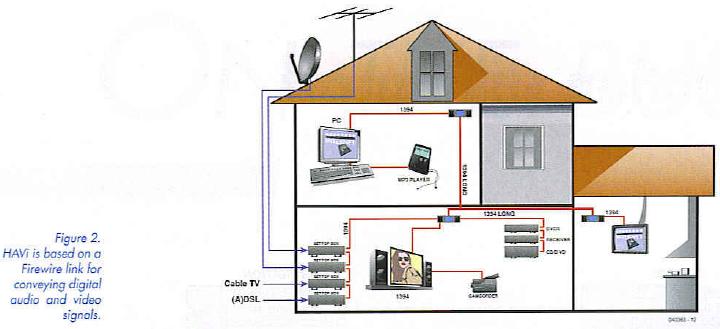

Project Solutions
On the Buses: Last station still far off 2
Published:2011/8/9 21:39:00 Author:Amy From:SeekIC
David Daamen
Networking
Standards like RS-485, Ethernet, FireWire, HomePNA HomePlug, MoCA, USB and XI0 are primarily descriptions of ways to communicate over a physical medium. HomePNA, for instance, is a standard with widespread use in the USA, describing how connections with speeds up to 240 Mbit/s can be established within the home using the (existing) telephone wiring. The Multimedia over Coax Alliance has published a standard based on the same principle: making use of existing cabling — in this case, coax cabling already installed in many homes for the distribution of (analogue) radio and TV signals. According to the MoCA, the standard is future-proof and capable of speeds up to 1 Gbit/s.
The HomePlug standard now ’on the rise’ in Europe also employs existing cabling — the mains wiring installed in your home. Speeds up to 14 Mbit/s are said to be within reach.
Arguably, wireless standards like Bluetooth, ZigBee, DECT, WiFi and IrDA also belong to the network category. The ’Bus Systems’ inset provides links to more information on all these standards.
In the network layer, the focus is on physical interoperability (connectivity), hence most standards do not go beyond the first layers of the OSI model.
The upshot is that such standards are not terribly useful without agreements on how data is being transmitted and this is where the need for a networking protocol becomes apparent. Today, IP (Internet protocol) is the most frequently used.
Communication
The comms layer comprises standards like BACnet, Bat-iBUS, EIB, EIBA, LonWorks and KNX. The latter will be reverted to below. These are primarily communications systems. The standards describe the data packets travelling up and down the network between machines (terminals), without a connection having been set up beforehand.
In this context, inter-operability is crucial. One of the ways to achieve it is to agree on a transmission scheme that’s not dependent on the data being sent. This will fit in very well in an ’open’ system, the protocols being universal and free for use by anyone. Incidentally, a system based on ’open’ specifications is eventually closed of its own accord when it is used in a certain application or configuration!
Application
Within the standards normally associated with this layer, the emphasis is on system and application management. Consequently, the main aim of the standard is to define a so-called network-independent API (Application Programming Interface). This category comprises standards like CEBUs, ModBus, PROFIBUS, HAVi, EHS, OSGi and UPnP.
Whereas CEBus is used predominantly in the US of A, initiatives like HAVi and UPnP refer to truly global developments. You may already have heard of UPnP, the concept of plug-and-play being familiar from the Windows/PC environment where it is fully integrated in the hardware and software concepts.
For clarity’s sake we should mention that there is an amount of overlap in the categories mentioned. For example, certain standards from the network category are often complemented with solutions for management and control. The opposite also applies where a certain medium is sometimes chosen as the basis for an application group. This applies to, for example, HAVi, a system with Its roots firmly in Firewire (IEEE 1394) and intended as a connection standard for digital audio and video signals (Figure 2).

Reprinted Url Of This Article: http://www.seekic.com/blog/project_solutions/2011/08/09/On_the_Buses__Last_station_still_far_off_2.html
Print this Page | Comments | Reading(301)
Article Categories
New published articles
· Imagination works with TSMC to develop FinFET process
Author:Ecco Reading(30180)
· XMOS pushes event-driven MCUs with lower price
Author:Ecco Reading(3461)
· Intel brings upgraded 32-nm SoC for smartphones
Author:Ecco Reading(3181)
· Micron pushes TLC 128-Gbit NAND flash
Author:Ecco Reading(3661)
· Intel will stop supplying desktop motherboards
Author:Ecco Reading(5231)
· Processor market was expected to regain strength in 2013
Author:Ecco Reading(3248)
· It was reported that TSMC sales fall steeply
Author:Ecco Reading(3390)
· Cisco, NXP work with auto wireless startup
Author:Ecco Reading(3530)
· Micron was impacted by manufacturing glitch
Author:Ecco Reading(3935)
· China can make 22-nm transistor by themselves
Author:Ecco Reading(3707)
· Chip market rebound is coming, according to survey
Author:Ecco Reading(3677)
· Sony, Toshiba will spend more on chips, iSuppli reports
Author:Ecco Reading(3714)
· Qualcomm becomes the 13th company to join NFC Forum board
Author:Ecco Reading(6028)
· TSMC increases building work for FinFET fab
Author:Ecco Reading(3692)
· TI plans to cut 1,700 jobs in OMAP shift
Author:Ecco Reading(4478)